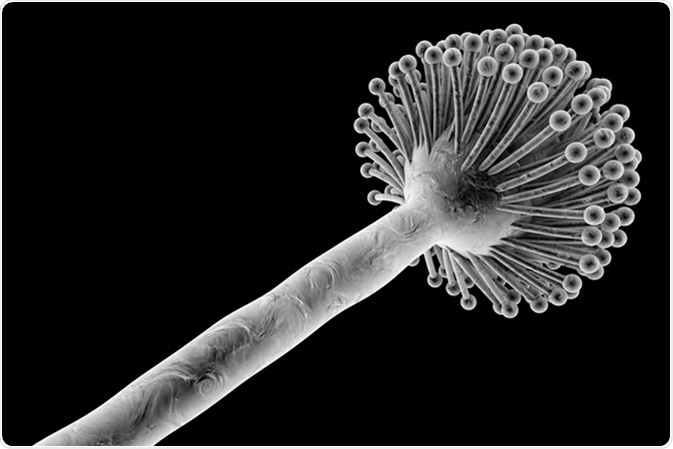By Sharma Das, PhD
Aspergillosis is a fungal infection caused by the Aspergillus mold. This infection primarily affects the immune system, with the lungs being the most common site of infection.

Fungi Aspergillus niger isolated on black background, black mold, which produce aflatoxins, cause pulmonary infection aspergillosis. Black-and-white image. Image Credit: Kateryna Kon / Shutterstock
Aspergillosis is broadly classified into different categories based on the site of infection and recurrence rates:
- Allergic bronchopulmonary aspergillosis/ABAP: an inflammatory condition in the lungs without causing infection.
- Allergic Aspergillus sinusitis: an inflammatory condition that affects the sinuses without causing infection.
- Aspergilloma/fungus ball: where the growth of the Aspergillus is restricted only to the lungs or sinuses.
- Chronic pulmonary aspergillosis: the growth of the Aspergillus is restricted only to the lungs. The infection remains for a prolong period and causes lung cavities.
- Invasive aspergillosis: lungs are the primary infection site, but gradually spreads to other organs; individuals with weak immunity, especially having organ or stem cell transplant usually gets affected.
- Cutaneous aspergillosis: the entry of Aspergillus is through broken skin cell; maybe after burn injury or surgical intervention; however, invasive aspergillosis can spread from lungs to the skin.
Prevalence of Aspergillosis
Aspergillus is frequently available in enclosed areaa, as well as in open air. Winter and autumn are two most favorable seasonal condition in Northern Hemisphere and correlate with a higher incidence of Aspergillosis than other seasons.
However, this infection can occur at anytime and anywhere across the globe. Individuals with strong immunity do not develop an infection, desspite inhaling aspergillus every day, but individuals with a medical history of tuberculosis or lung diseases (e.g., asthma or COPD) are at high risk of infection.
What is aspergillosis?
Symptoms
The symptoms vary depending on which category the infection falls into.. However, respiratory tract oriented symptoms are common in most cases.
Symptoms of ABAP:
Common symptoms of asthma such as wheezing, coughing, breathing difficulty, shortness of breathing, and in some cases fever.
Symptoms of allergic Aspergillus sinusitis:
The symptoms are a runny nose, stuffiness, headache, and impaired smelling ability.
Symptoms of an aspergilloma:
The associated symptoms are a cough, hemoptysis (coughing up blood), and shortness of breath.
Symptoms of chronic pulmonary aspergillosis:
The symptoms include a chronic cough, hemoptysis (i.e. blood-stained mucus excreted with coughing), weight loss, fatigue, and shortness of breath.
Symptoms of invasive aspergillosis:
It is sometimes difficult to identify the actual cause of the associated symptoms, which may be due to Aspergillus infection or may occur due to other underlying disease conditions. The symptoms of invasive aspergillosis affecting lungs are fever, cough, chest pain, shortness of breath and coughing up blood. However, spreading of infection to other parts causes site-specific symptoms.
Symptoms of cutaneous aspergillosis:
This is a rare Aspergillus infection and occurs in immunosuppressed patients. Cutaneous aspergillosis is further divided into two types - primary cutaneous aspergillosis and secondary cutaneous lesions. In primary cutaneous aspergillosis, the Aspergillus species directly enters the skin from traumatic injuries, such as catheterization, contaminated dressings etc. Whereas, the secondary cutaneous lesions are the outcome of infection entering the skin from adjacent infected tissues or through blood-borne infectious germ.
The symptoms of cutaneous aspergillosis are redness of skin (erythematous), skin bumps (papules), alter skin coloration with increased skin thickness (indurated macules), and plaque formation that may convert to necrotic ulcers with black eschar covering. In rare cases, nodules and pustular lesions are also reported.
Diagnosis
Laboratory tests are the essential part of diagnosis after the symptomatic analysis, which includes:
- Chest X-ray
- Blood test
- Sputum test or mucus test
- Allergy tests
- Bronchoscopy to visualize the lungs by inserting thin, flexible tube which is attached to a small camera at the lower end.
- Chest CT scan
Treatment
The treatment approach varies with the type of Aspergillosis. The antifungal drugs increase the survival rate by 15 to 20 percent for patients suffering from invasive aspergillosis.
Allergic bronchopulmonary aspergillosis can be treated with oral and inhaled steroidal drugs. The steroids have several side effects including weight gain, skin thickening and porous bone (osteoporosis), whose dose can be reduced by co-prescribing anti-fungal drugs.
Steroidal drugs may be locally applied for a short duration of time to reduce inflammation due to Allergic Aspergillus sinusitis. Oral antifungal drugs are the drug of choice. Allergic Aspergillus sinusitis may require surgical interventions like polyp removal or drainage in severe cases.
Surgical removal of single fungus ball along with prescribed antifungal drugs are the preferred therapeutic management in Aspergilloma. However, the surgical procedure is not possible in case of multiple fungus balls.
Chronic pulmonary aspergillosis needs lifelong antifungal therapy. In some cases, antifungal drugs are directly injected into the cavity through insertion tube under local anesthesia.
Therapeutic management of Invasive aspergillosis requires hospitalization, as antifungal medication directly injected into the vein.
Precautionary Measures
It is quite impossible to prevent exposure to Aspergillus. Therefore, individuals with lung diseases or weak immunity should avoid close contact with composite heaps or dead leaves where the growth of Aspergillus mold is higher than average. Precautions which may be helpful include:
- Using face mask in dusty areas.
- Installing HEPA filters at home to purify the air.
- Avoiding drying wet clothes inside the room.
Further Reading
Last Updated: Feb 26, 2019